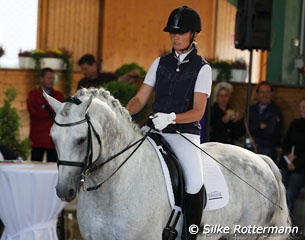
After a short lunch break the seminar continued with practical demonstrations which were mainly commented on by moderator Christoph Hess, FN Head of Education and an international judge. Featuring seven horses of different training levels throughout the afternoon, the demonstration began with a 4-year-old Westfalian stallion and theory was put into practice.
(Also read part I of the 2011 FN Young Horse Seminar and Judges Course)
Putting Words into Action: Practical Demonstrations from A to S-Level
It was good to see, and welcomed by the attendants, that all riders wore helmets to set an example unlike two years ago. If only they would do the same in the warm-up rings, where children and teenagers were watching during the Bundeschampionate, but that is another issue.
First to go was “Dankeschön” (by Danone I x Fidermark), a good type of horse presented by Anja Wilimzig who works for the National State Stud in Warendorf. At age 4 Dankeschön was quite impressed with the foreign surroundings and first was looking around a bit and whinnying repeatedly.
As he was a bit tight in the neck at the beginning, Hess asked his rider to open the frame of the horse, even though the conditions were not easy for doing that. Wilimzig revealed much talent, riding the excited liver-chestnut with feeling and precision and brought him more constantly in front of the vertical in trot and canter.
Hess elaborated on it: “The more a young horse learns to stretch onto the bit, the more it’s moving under the centre of gravity. The rider has to feel which gait is the one a horse favours and we can start with that. For working a young horse it is important to have a constant change of sitting and rising trot, sitting canter and such standing in the stirrups.”
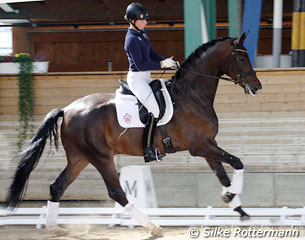 Next to go was the 4-year-old Sungai, a Westfalian gelding by Sorento x Londonderry, under Ann- Christin Wienkamp; who had become the new Bundeschampion of the 4-year-old geldings and mares 2 days before. This very noble and elegant dark bay moved with remarkable uphill tendency and a quick hind leg.
Next to go was the 4-year-old Sungai, a Westfalian gelding by Sorento x Londonderry, under Ann- Christin Wienkamp; who had become the new Bundeschampion of the 4-year-old geldings and mares 2 days before. This very noble and elegant dark bay moved with remarkable uphill tendency and a quick hind leg.
”This is a horse which moves with positive tension indeed. He’s active, uphill and on the aids, he wants to work,” Hess said of Sungai, but he also warned that “with young horses one is quicker on a wrong path than with an older horse.”
Sungai’s huge uphill and rhythmical canter is hard to top, still Hess pointed out that “it needs time to counterbalance such a canter. It is very important because without balance there’s a loss of rhythm.” Wienkamp was asked to ride Sungai in walk on long reins to see if he maintained the rhythm. It was probably the kind of walk Katrin Burger was looking for in her presentation: rhythmical, enough overtrack, but not too big.
Using the example of Sungai Hess also made clear that it is important to observe the movement of a horse’s ears and tail to find out about its contentment.
Damon Jerome H and Don Diamond Show M and S-level Work
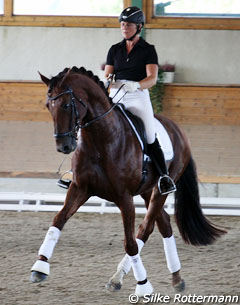 Uta Gräf and her reserve world and German Young horse champion Damon Jerome H were the next pair to appear to demonstrate M level dressage. Horse and rider have already attended the same seminar with Christoph Hess two years earlier and both probably display best what is near and dear to Hess: outstanding harmony between man and animal.
Uta Gräf and her reserve world and German Young horse champion Damon Jerome H were the next pair to appear to demonstrate M level dressage. Horse and rider have already attended the same seminar with Christoph Hess two years earlier and both probably display best what is near and dear to Hess: outstanding harmony between man and animal.
Uta Gräf showed the shortening and lengthening of the strides in trot in a perfect manner without giving visible aids. “What you see here is perfect riding. She’s shortening and lengthening only by her seat thereby the horse maintains the perfect rhythm, he never gets hasty.”
Gräf went on to demonstrate the same on a circle in canter with the similar brilliance, animating Hess to enthuse about her equitation: “Just perfect! I could watch this endlessly. 24 hours a day are not enough.”
A year older than Damon Jerome H is the licensed Baden Württemberger Don Diamond (by Diamond Hit- Carolus) owned by Birkhof Stud. The winner of the South German licensing 2007 and the 30-day performance test is ridden by Nicole Casper, wife to stud owner Thomas Casper. And the horse is an old acquaintance of Warendorf, as 2009 reserve Bundeschampion and finalist last year.
This season he qualified for the Nürnberger Burgpokal final and won S- classes up to Inter I so the assumption was to see a very obedient horse with lots of rideability. In fact the liver chestnut confirmed the expectations, presenting himself interested in his surroundings, but completely relaxed, content and obedient. Casper, who like all other riders had already properly warmed-up her stallion in the older indoor arena nearby, showed very good canter pirouettes in a snaffle bit. Don Diamond had apparently no effort at all in doing this difficult Inter I movement.
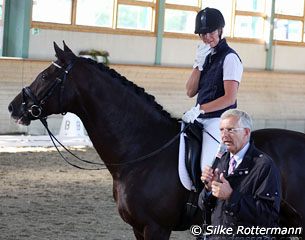 Hess agreed with the impression by saying “these are lovely pirouettes. I have the feeling the horse loves this movement, there’s a motivation in it.” He made clear that a horse has to maintain the rhythm in whatever it is doing even though it is such a demanding movement. In the flying changes one could feel that the horse was absolutely focused on his rider, but one wished Don Diamond would stretch the neck in canter a bit more. O-judge Dr. Schüle advised to ride the horse more forward in the otherwise straight flying changes.
Hess agreed with the impression by saying “these are lovely pirouettes. I have the feeling the horse loves this movement, there’s a motivation in it.” He made clear that a horse has to maintain the rhythm in whatever it is doing even though it is such a demanding movement. In the flying changes one could feel that the horse was absolutely focused on his rider, but one wished Don Diamond would stretch the neck in canter a bit more. O-judge Dr. Schüle advised to ride the horse more forward in the otherwise straight flying changes.
Nicole Casper showed her first attempts of piaffe and passage. In particular the first piaffe steps were convincing, because the stallion manifested that he is worked correctly. Often we see horses at his age, and unfortunately also Grand Prix-horses, piaffing heavily on the forehand even though it might be a good piaffe at first glance because front and hind legs are lifted off the ground. However, this is only one aspect of a good piaffe, the other more important one is that the horse carries weight on the hind legs which can be recognised at a lowered croup and lifted shoulders in front so that the horse gives the impression being higher in front than behind.
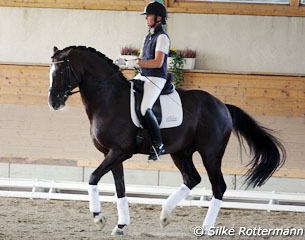 Don Diamond already gave this picture to some extent in the few steps he executed.
Don Diamond already gave this picture to some extent in the few steps he executed.
Hess brought to mind that such a willing horse might betray the rider to ask for too much. He encouraged Casper only to ask for the few steps she had ridden and then to ride forwards again. After her ride Nicole Casper said some words on the horse which she considered to be one of the best she had so far: “He is very willing and works very motivated in his training. My aim is to make him more experienced in the S- movements, which in general he has comprehended.”
Casper said the piaffe work shows the obedience of the horse in the training more than in forward movements. “We started piaffe work a little bit when he was 4, but then we didn't touch upon it for a while.”
Working towards Grand Prix
Last horses for the afternoon demonstration were two identically aged stallions: Kathrin Meyer zu Strohen’s Burgpokal winner of 2010, Rassolini (by Rubioso N x Silvano N) and Casper’s second stallion Denario (by Denaro x Fair Play), a double Bundeschampion at 4 and 6.
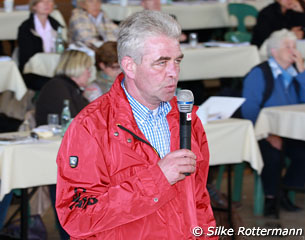 Rassolini is a stunning Hessian stallion who was born for dressage as his sire and in particular his grandsire Silvano had been successful dressage horses under Ellen Bontje.
Rassolini is a stunning Hessian stallion who was born for dressage as his sire and in particular his grandsire Silvano had been successful dressage horses under Ellen Bontje.
Kathrin Meyer zu Strohen presented him under the eagly eye of her husband Heinrich Meyer zu Strohen. He portrayed the straightforward career of this highly talented liver chestnut who had been in the Bundeschampionat finals three times, two times placing 4th, which he also did at the World championships of the 6-year-olds in Verden 2009.
“For training horses I have a golden thread which I follow," said Hans Heinrich. That this golden thread works could be seen in the settled and copy-book- style small canter pirouettes. It was interesting to have Denario in comparison right after Rassolini.
The dapple grey Bavarian stallion with the sympathetic expression in his face showed great harmony with his rider and made a very relaxed impression, prompting Hess to comment: “The horse is always a mirror of the rider. All horses we see today trust their riders. The more one fights with the horse, the more the horses are losing faith.”
Hess praised the walk of Denario as highlight of the 8-year-old: “He’s always relaxed, moves freely out of the shoulder and has enough overtrack. I also think the walk pirouettes are top-class: small and thereby maintaining the rhythm.”
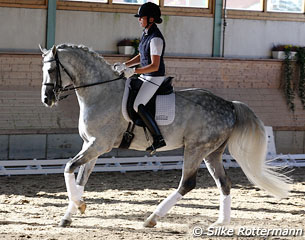 After the demo Nicole Casper disclosed to the audience that Denario looks obedient, but this hadn’t been the case at the beginning of their partnership. “Up to M everything was so easy for him. Now we work on the Grand Prix movements and my plan is to start at Inter II-level next season. When the outside influences are changing he sometimes doesn’t listen as well to me as I would like him to do. So at home we train unspectacular things, for example many transitions so he listens better to me.”
After the demo Nicole Casper disclosed to the audience that Denario looks obedient, but this hadn’t been the case at the beginning of their partnership. “Up to M everything was so easy for him. Now we work on the Grand Prix movements and my plan is to start at Inter II-level next season. When the outside influences are changing he sometimes doesn’t listen as well to me as I would like him to do. So at home we train unspectacular things, for example many transitions so he listens better to me.”
Denario’s comparatively flat canter executed with a straight foreleg caused an attendant of the seminar to ask how the rider could improve this movement? Dr. Schüle recommended to ride the horse more forwards than collected to maintain the activity. Casper confirmed that Denario could indeed move more freely from the shoulder: “But every horse has a crucial point. I cannot completely ignore collection in canter in my training because I need it for the pirouettes and flying changes.”
Final Seminar Day: Judging and Improving
Whereas on Monday the theoretical and practical part with demonstrations was split between the morning and afternoon, the last day was dedicated to judging programmes from L to S- level and talking about criteria one has to pay attention to while judging. Four riders rode the new tests which are ridden nationally in Germany from 2012 on.
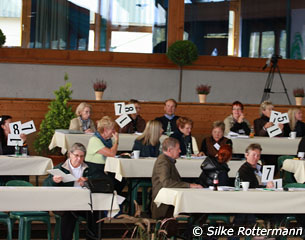 Before each ride the seminar attendants got a score sheet and had to give marks on each gait. The rides were subsequently shown on big flatscreens for a second time before one set a final mark.
Before each ride the seminar attendants got a score sheet and had to give marks on each gait. The rides were subsequently shown on big flatscreens for a second time before one set a final mark.
Everybody had to show his or her mark awarded, but mostly only the highest and lowest mark were discussed and justified.
Johnny Hilberath, German national coach, supported Christoph Hess in commenting on it all and from his trainer’s point of view gave tips how to improve weak spots which were more or less clearly revealed by the video clips.
The first pair, Claudia Rüscher on the 5-year-old black gelding Roy Black, a son by Rubin Royal x Donnerhall, rode the new L-level programme with a snaffle bit. The test includes a phase where the horse has to stretch onto the bit in long reins in trot.
Rüscher showed a professional, pleasant ride, but the leggy beautifully moving horse could have been more constantly in front of the vertical.
The seminar participants were awarding marks for example for the trot between 6,8 (given by an experienced journalist from Germany’s most renowned equestrian magazine) to 8,0. Both valued the good rhythm, but the lady journalist quite rightly criticised that the horse has to use its back in a better way. Christoph Hess gave the advice not to begin judging from 0 upwards, but from 10 downwards: “Always look on the good side of a horse before you start criticising.”
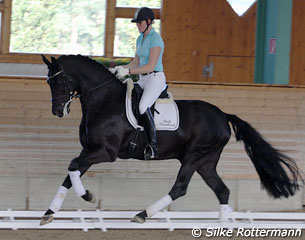 Johnny Hilberath spoke on the issue of getting more self carriage and more neck stretching: “This horse has a nicely uphill constructed neck. It’s essential to bring the elevation and the back more on one line. In the training horses should not be over paced to be able to work more over the back. For that one can ride many transitions in between the basic gaits and from one to another. Also leg yielding is very useful for the back. It’s a process. Horses need to be strengthened over weeks and months.”
Johnny Hilberath spoke on the issue of getting more self carriage and more neck stretching: “This horse has a nicely uphill constructed neck. It’s essential to bring the elevation and the back more on one line. In the training horses should not be over paced to be able to work more over the back. For that one can ride many transitions in between the basic gaits and from one to another. Also leg yielding is very useful for the back. It’s a process. Horses need to be strengthened over weeks and months.”
A horse which owns an extremely uphill constructed neck was the next in the ring, the Rhinelander Damon Jerome who is by Helen Langenhanenberg’s team horse Damon Hill out of a Trakehner state premium mare.
He gave perhaps one of his best rides in an M-level programme, being light in the bridle, effortlessly floating from collected to forward movements, perfectly working over the back and coming under the centre of gravity. Subsequently the audience awarded high marks and Hess was as excited: “This horse showed a perfect rhythm, it’s stretching ideally over the back. “ I think the expert audience shared his opinion and one woman made a very important remark: “I really like that your horse is honestly stretching downwards and forwards and is not curling.”
Indeed Damon Jerome had also been one of only few horse working in a proper stretching position in the warm-up ring two days before while several horses went in a deep behind the vertical head-position.
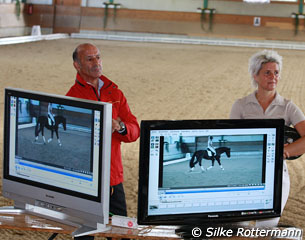 The last two horses of this midmorning were the Baden Württemberger gelding Dave FBW, ridden by Nicole Casper and Uta Gräf’s international Grand Prix winner Le Noir, an 11-year-old Holsteiner stallion with a pure jumping pedigree.
The last two horses of this midmorning were the Baden Württemberger gelding Dave FBW, ridden by Nicole Casper and Uta Gräf’s international Grand Prix winner Le Noir, an 11-year-old Holsteiner stallion with a pure jumping pedigree.
Like Casper’s two other horses Dave has also competed successfully at small tour level this season and like Don Diamond has qualified for the Burgpokal final in December. Dave also displayed the great obedience and co-operation Casper's other horses had shown, though of course technical details could be criticised and they were discussed with the help of the video clip to better school
the eyes.
Before Christoph Hess closed the four days of an educational international dressage seminar Le Noir presented some Grand Prix movements like the canter pirouettes and the piaffe. Hess concluded: “This is the spirit of Grand Prix. From a total relaxation to the highest collection. This is perfection.”
Text and Photos by Silke Rottermann © Eurodressage
Also Read: Part I: A Coming Together of Minds at the 2011 FEI Young Horse Seminar and Judges Course
Related Links
A Coming Together of Minds at the 2011 FEI Young Horse Seminar and Judges Course
FEI Endorsed Young Horse Seminar and Judges Course to be Held at 2011 Bundeschampionate